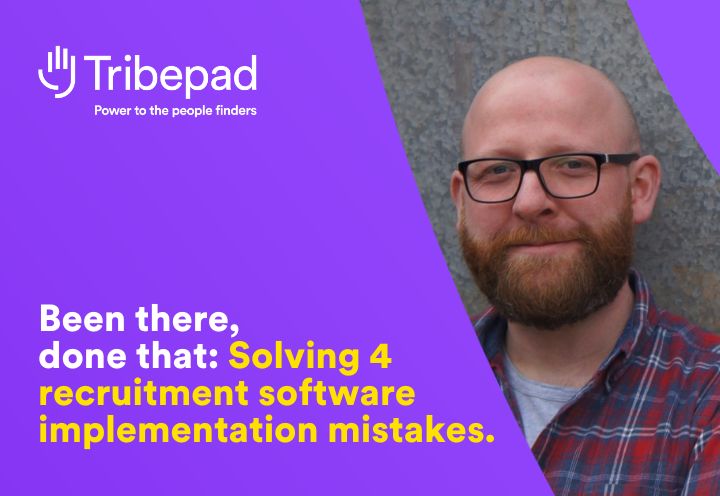Careers are made on great recruitment software implementations. But trust is broken and relationships soured if you make promises you don’t deliver. The stakes are high. Here are our six top tips for ensuring your implementation runs on-time, on-budget, and delivers what you expect.
The implementation process is one of the most common concerns about buying new recruitment software. After all – you’re a recruiter, not a project manager.
So, sure. You love the tech. That’s why you chose it. But it can feel like there’s a mountain to climb between vision and execution.
- Will the ATS go live on-time, or could the project snowball into a time-consuming, stressful embarrassment?
- Will the new software actually deliver the value you’re expecting, or become an elephant in the room until your contract expires?
Tribepad’s project delivery team have 3 decades’ combined experience helping TA teams implement recruitment software, so we have a great understanding of what makes a project smooth sailing versus choppy waters.
Here are our top tips for an ATS implementation that delivers the value you paid for.
Six tips for successful ATS implementation
1 – Plan internal resource upfront
Lack of internal resource is one of the biggest roadblocks to on-time implementation.
Your ATS provider should (hopefully) give you a clear roadmap of what’s needed when, so use that plan upfront to make sure you’ll be appropriately resourced throughout.
Read more: Roadmap for implementing enterprise recruitment software
Read more: Roadmap for implementing an SME ATS
If you’re implementing Tribepad Pro, for instance, we say you’ll need around two days/week split between two to three people for either 11 or 15 weeks depending whether you want onboarding. (That differs week-by-week so we’ll give you a full weekly breakdown.)
Implementation runs most smoothly when you sit down upfront and map out:
- Who are those people – and who’ll cover them if they’re sick or absent?
- What else are they juggling each week that might impact their availability?
- What holidays do they have booked for the duration of implementation?
It sucks to get half-way through implementation only to realise Sally’s away for the next three weeks, and Jack’s snowed under with your latest graduate recruitment drive.
Planning upfront gives you visibility over what’s coming down the track, and helps you be realistic about the deadlines you commit to.
2 – Map your recruitment process first
In essence, implementing recruitment software means taking third-party software and making it your own, so it can support your organisation’s recruitment process.
(Although the extent to which your software flexes to you depends what you’ve bought. For example, Tribepad Gro is more out-of-the-box for growing teams; Tribepad Pro is enterprise recruitment software with near-endless flexibility.)
It might sound obvious, but that’s pretty difficult to achieve if you don’t know exactly what your recruitment process is. That can be challenging whatever your size.
- For smaller organisations, you might never’ve formally mapped your processes. And you’re likely upgrading recruitment software because recruitment is in a state of flux anyway, so everything can feel a little in the air.
- For enterprises, you might have extremely complicated processes, users, divisions that need different permissions and capabilities, and interact in complex ways. Getting to grips with that complexity can be a major challenge.
A common issue is teams only considering their own perspective – in Tribepad language, your super-users, who have the run of the system. But how will other users work within the system? What do hiring managers need to see? How do requisitions work for resourcers?
The more clarity you have around your process, the smoother implementation will be.
But remember, your provider should be able to help you here if you’re not sure. Good recruitment software providers should be partners. They have way more visibility than you into what lots of other teams do, and can advise on how to achieve your goals using their tech. A flexible, curious mindset is usually much smarter than a fixed, rigid one.
3 – Be proactive
The main chunk of implementing Tribepad is the building and testing process. Each week you’ll have specific tasks – outlined in your project plan – and weekly project calls with our delivery team.
❌ The point of these calls isn’t to brief you on what’s needed that week.
✅ The point of these calls is to review progress, troubleshoot issues, answer questions, and flag what’s happening next week.
ATS implementation will go most smoothly if you come prepared for these calls having already tackled (or tried to tackle) the week’s tasks. And be upfront if you’re struggling! If you flag problems as soon as they crop up, your project delivery team can work out what’s best to keep your project on-track.
4 – Bring a clear vision
Ultimately you chose to implement recruitment software because you believe it’ll be better for your team and the organisation. It’s crucial to come into the implementation process with clarity around what the ‘better’ that you’re trying to achieve, so you can demonstrate success.
- What are your goals?
- How will you know if you’ve met them?
- Are there specific metrics that could align?
The truth is, a successful implementation is only partially about delivering new recruitment software. It’s also about showing internal stakeholders that you’ve delivered.
Outside talent acquisition, other senior leaders might have no idea what your new ATS means for the organisation. Stuff like happier managers, faster processes, more engaged candidates, and more trustworthy compliance aren’t obviously visible.
You needed other leaders’ engagement to build your business case and secure investment. Part of implementation should be closing the circle, showing them what investment has delivered.
5 – Commit to a full roll-out
Sometimes teams suggest rolling-out a minimum viable product, so they have basic functionality up-and-running fast with a view to sorting the rest out later. On the surface this makes sense but in reality, it’s rarely the best approach for maximising value from your new tech.
Typically:
😩 It means you end up not using all the features you’ve paid for, which hurts ROI. There’s no point paying for stuff you don’t use.
😩 It extends implementation for longer, taking time away from recruitment-as-usual and hurting recruitment delivery.
😩 It means you have to retrain recruiters and managers as bits are added or change, which often causes confusion and new tech fatigue.
😩 You never get that brilliant ‘ahhhhh and we’re done’ moment…!
We’d always recommend you stick to the project plan and roll-out what you’ve paid for. It might feel a little intimidating but it’s easier than you think and be 1000% worth it when you’re done.
6 – Use the project management software 👀
We know, nobody likes learning new software. And you’re already learning one new piece of kit, with your new ATS. But we onboard our customers onto dedicated project management software for a reason – and that reason is that it’s absolutely the best way to keep your implementation flowing smoothly.
The project management software:
- Holds your bespoke project plan
- Advises how much time’s needed each week
- Breaks down weekly tasks with start and due dates
- Notifies you when you need to do stuff
- Stores training docs and resources next to relevant tasks
- Tags the whole project team in questions for speedy replies
- Collects and tracks communication so nothing’s lost in email threads
At the start of implementation, you’ll have a dedicated training session to make sure you’re totally confident with the project management tool. Please use it, we promise it’ll make life easier.
Remember the stakes: fairer, faster, better recruitment for everyone
Even with these tips, implementing recruitment software can feel like a lot. We get it. But don’t lose track of why you’re choosing new tech in the first place.
Setting-up a new ATS was never going to be as easy as settling for what you currently do, whether that’s a legacy system or endless spreadsheets.
But you’re here because you know that settling for what you currently do means you’ll be stuck with the same results you’re currently getting. And you know that’s not good enough – not now, and certainly not for the next three years or however long your contract runs for.
You’ve done the hardest bit. You’ve decided you need a change. You’ve successfully made your case for investment. Now’s the final hurdle: in a matter of months, you’ll be recruiting how you’ve always been imagining 💪🏻
Tribepad is the trusted tech ally to smart(er) recruiters everywhere. Combining ATS, CRM, Video Interviewing, and Onboarding, our talent acquisition software is a springboard for fairer, faster, better recruitment for everyone.
Trusted by organisations like Tesco, NHS Professionals, and Subway, 25-million people in 16 languages use Tribepad.




